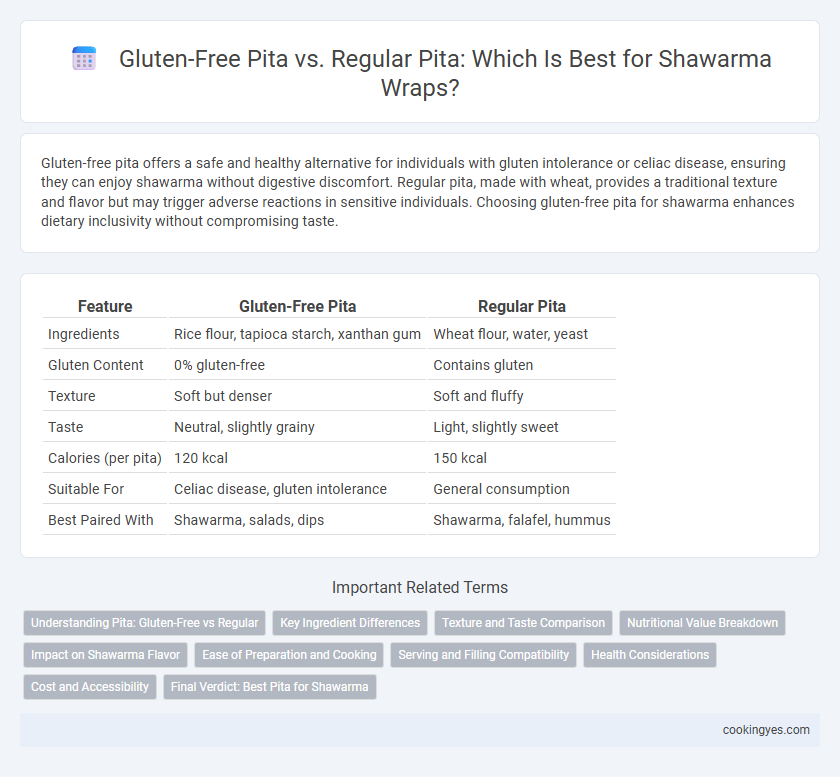Gluten-free pita offers a safe and healthy alternative for individuals with gluten intolerance or celiac disease, ensuring they can enjoy shawarma without digestive discomfort. Regular pita, made with wheat, provides a traditional texture and flavor but may trigger adverse reactions in sensitive individuals. Choosing gluten-free pita for shawarma enhances dietary inclusivity without compromising taste.
Table of Comparison
| Feature | Gluten-Free Pita | Regular Pita |
|---|---|---|
| Ingredients | Rice flour, tapioca starch, xanthan gum | Wheat flour, water, yeast |
| Gluten Content | 0% gluten-free | Contains gluten |
| Texture | Soft but denser | Soft and fluffy |
| Taste | Neutral, slightly grainy | Light, slightly sweet |
| Calories (per pita) | 120 kcal | 150 kcal |
| Suitable For | Celiac disease, gluten intolerance | General consumption |
| Best Paired With | Shawarma, salads, dips | Shawarma, falafel, hummus |
Understanding Pita: Gluten-Free vs Regular
Gluten-free pita offers a suitable alternative for individuals with gluten intolerance or celiac disease, made typically from rice flour, tapioca starch, or chickpea flour, while regular pita primarily contains wheat flour rich in gluten. The texture of gluten-free pita tends to be denser and less pliable compared to the soft, chewy consistency of traditional wheat-based pita, affecting the overall shawarma experience. Nutritionally, gluten-free options might have varying fiber and protein levels, influencing digestion and satiety when paired with savory shawarma fillings.
Key Ingredient Differences
Gluten-free pita for shawarma typically uses alternative flours like rice flour, almond flour, or chickpea flour instead of traditional wheat flour, which contains gluten. This key ingredient difference affects texture and binding, with gluten-free versions often relying on xanthan gum or psyllium husk to mimic elasticity. Regular pita's gluten network provides a chewy, soft texture essential for wrapping shawarma fillings securely.
Texture and Taste Comparison
Gluten-free pita for shawarma offers a denser and slightly crumbly texture compared to the soft, chewy consistency of regular pita, which is often preferred for wrapping due to its pliability. Taste-wise, gluten-free pita may have a milder flavor with subtle grain notes, whereas regular pita boasts a classic, slightly yeasty taste that complements the savory shawarma filling. Choosing between them depends on dietary needs and texture preference, with regular pita providing a traditionally satisfying bite and gluten-free pita catering to gluten sensitivities without sacrificing the essence of the dish.
Nutritional Value Breakdown
Gluten-free pita typically contains alternative flours such as rice or almond flour, offering lower carbohydrate content and increased fiber compared to regular pita made from wheat flour. Regular pita provides a higher protein level due to gluten, which supports muscle repair and satiety, while gluten-free versions may include added nutrients like vitamins and minerals to compensate for reduced wheat components. Both types can fit into a balanced diet, but gluten-free pita benefits individuals with celiac disease or gluten sensitivity by avoiding gluten-related inflammation.
Impact on Shawarma Flavor
Gluten-free pita, often made from alternative flours like rice or chickpea, offers a different texture and slightly nutty flavor that can subtly alter the traditional taste profile of shawarma. Regular pita, made with wheat flour, provides a soft, chewy base that complements the savory spices and juicy meat of shawarma, enhancing its overall mouthfeel and flavor absorption. Choosing gluten-free pita can benefit those with gluten intolerance while slightly modifying the authentic flavor experience of traditional shawarma.
Ease of Preparation and Cooking
Gluten-free pita offers ease of preparation by eliminating the need for gluten-containing flours, which can simplify ingredient sourcing and reduce cross-contamination risks during cooking. Regular pita dough typically requires gluten development through kneading and resting to achieve its characteristic texture, making it slightly more time-intensive. For shawarma, gluten-free pita can be quicker to cook due to typically thinner, more pliable dough, while regular pita often puffs up during baking, requiring close attention to prevent burning.
Serving and Filling Compatibility
Gluten-free pita offers a versatile option for those with gluten intolerance while maintaining the soft texture ideal for shawarma fillings like grilled meats, fresh vegetables, and sauces. Regular pita's traditional elasticity and sturdiness provide excellent support for heavier or saucier shawarma ingredients but may cause discomfort for gluten-sensitive individuals. Choosing between gluten-free and regular pita depends on dietary needs without compromising the compatibility with classic shawarma serving styles.
Health Considerations
Gluten-free pita offers a safe alternative for individuals with celiac disease or gluten sensitivity, reducing digestive discomfort and inflammation caused by gluten proteins found in regular pita. Regular pita, typically made from wheat flour, contains higher levels of gluten, which can trigger adverse health reactions in sensitive individuals. Choosing gluten-free pita for shawarma ensures better gut health and minimizes autoimmune responses linked to gluten intake.
Cost and Accessibility
Gluten-free pita for shawarma typically costs 30-50% more than regular pita due to specialized ingredients and production processes. Regular pita remains widely accessible in most grocery stores and Middle Eastern eateries, while gluten-free options are often limited to specialty or health food stores. Consumers seeking gluten-free pita may face higher prices and reduced availability, impacting convenience and budget considerations.
Final Verdict: Best Pita for Shawarma
Gluten-free pita provides an excellent alternative for those with gluten sensitivities, offering a similar texture and taste that complements shawarma fillings without compromising dietary restrictions. Regular pita maintains a traditional chewy texture and is preferred by many for its authentic flavor profile, enhancing the overall shawarma experience. For the best pita in shawarma, choose gluten-free options if avoiding gluten is essential, otherwise, regular pita remains the favored choice for its classic taste and versatility.
Gluten-Free Pita vs Regular Pita for Shawarma Infographic

 cookingyes.com
cookingyes.com